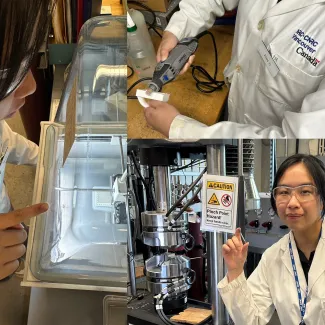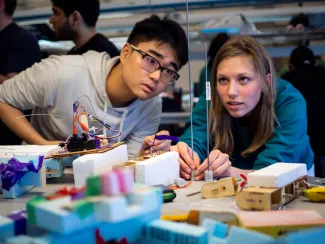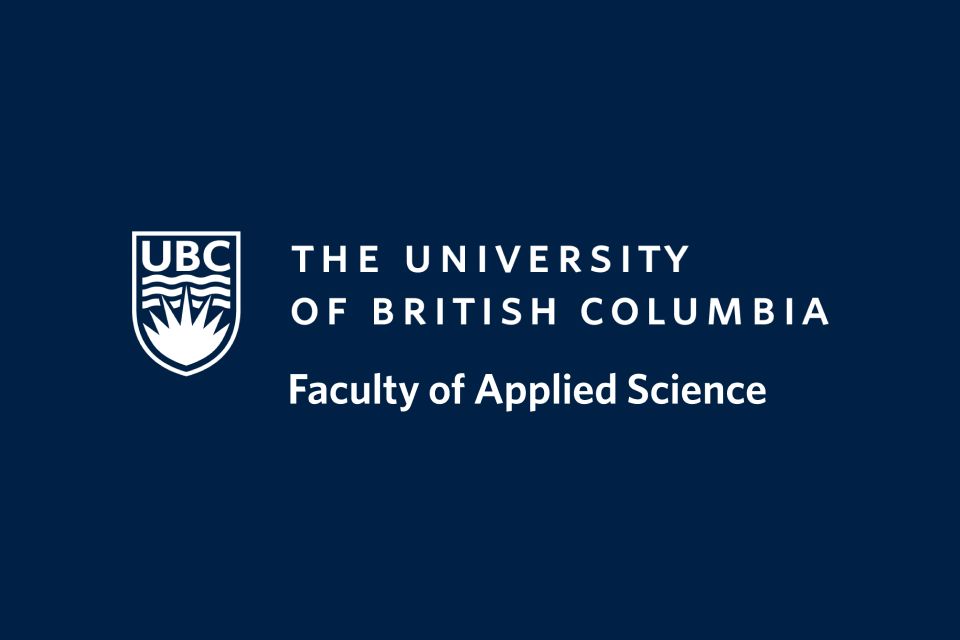"You get out what you put in. Co-op gave me the foundation to access certain job positions, but had I not had a vision for what I wanted to get out of each work term, my experience would’ve been very different."

Alice Xie
- Degree:
- Bachelor of Applied Science
- Program:
- Campus: Okanagan
How did you get interested in engineering?
I was actually set on being a psychiatrist and had been accepted at the University of Toronto for a psychology program. But then towards the end of my Grade 12 year I realized I wasn’t that keen on spending more than a decade of my life in school. I began reflecting on what careers I could pursue that would be fulfilling and that matched up with my passions.
I kept coming back to my fascination with aerospace that started when I was around seven with documentaries investigating plane crashes. They often included in-depth explanations about the physics behind material or mechanical failures. I realized that engineering was an area where I could pursue my interests in how and why things work. And as luck would have it, UBC Okanagan still had some spots open in their engineering program and I was able to submit a last-minute application and be accepted. Choosing mechanical engineering with an aerospace concentration was a natural decision for me as I have ambitions of pursuing a career in aerospace engineering.
Your employment history shows that you completed 20 months of engineering-related work experience having only completed one semester of second-year engineering! Tell us about your first co-op term at Transport Canada.
After completing the first semester of my second year of engineering, I began an eight-month co-op term with Transport Canada as a network analyst. Although this position wasn’t related to my focus on mechanical engineering, I am doing a minor in computer science and have a hobbyist knowledge of the area – both of which likely helped me get the job.
I helped maintain the IT infrastructure used by federal employees, learned how to use a bunch of new tools and was able to travel across BC to conduct site and server inspections. It was very cool to see all the server rooms, learn how they work and gain some knowledge about how government organizes its networks.
You’ve said your most recent position at the National Research Council was your all-time fave. Tell us what made this such a great co-op experience.
I had intended to go back to school in January 2024 after my term with Moment Energy, but an opportunity came up for an eight-month R&D co-op with the National Research Council Canada.
For context, the federal government has a goal to be net zero by 2050, and one of the strategies to reach that goal is to blend hydrogen with natural gas. This would make use of existing pipeline infrastructure while reducing the carbon emissions associated with burning natural gas. One challenge with doing this is the risk of hydrogen embrittlement, which is when metals absorb hydrogen atoms and then become more susceptible to cracking. The NRC is looking at ways to reduce that risk.
During my first few months of co-op I analyzed a ton of research papers to build a database on the mechanical properties of hydrogen embrittlement on pipeline steels. I also performed many electrochemical experiments to test the baseline corrosion rates of pipeline steels and aerospace alloys and then tested those rates in different conditions.
A few months in, I talked with my project manager about transitioning my role. I was soon conducting tensile tests on pipeline steel dog bone specimens using a hydraulic test system that exerts an incredible amount of force.
You can gain a lot of information about the material by analyzing when and how it breaks.
Independently, I then used SolidWorks to design and render pictures of assembly models of our experimental setups and material testing specimens. These renderings have been used in research papers and presentations, and have also been sent to the machine shop as a supplementary visual. I also designed and 3D printed sample holders.
Being involved in hands-on work and doing everything from design to testing made me truly feel like a “real” engineer during this co-op term, which is why this has been my favourite co-op term yet.
I really enjoyed the tasks I was given and knowing that my efforts were going towards a cause that would benefit the world around me. It also sparked an interest for me in materials engineering.

Any advice to students just starting out in co-op?
You get out what you put in. Co-op gave me the foundation to access certain job positions, but had I not had a vision for what I wanted to get out of each work term, my experience would’ve been very different.
You are there to learn how to become a better engineer. Of course you need to do all of the tasks you are responsible for, but it also means identifying ways you might be able to expand your experience. I believe it’s important to regularly ask yourself: “Are there areas where I can add value to the organization that also enable me to add to my own knowledge and gain new skills?” You can really learn and achieve so much if you are intentional about it.
Also, I know the job market might seem daunting, particularly if you haven’t completed a work term, but things get a lot easier once you get that first foot in the door. Talk to your co-op advisor often! A huge shout-out to my co-op advisor, Hayden Soboleski, who has been amazing.





